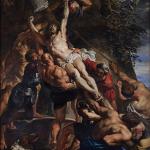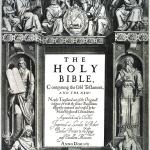Peter Enns raises many of the standard objections to the Bible in The Bible Tells Me So . . . : Yahweh’s command to slaughter the Canaanites, contradictions in Scripture, historical errors and unscientific claims.
His answers are pretty standard too. Christian don’t need to worry about God’s command to kill the Canaanites because He never commanded it. Israel did. Contradictions are just what we would expect from fallible human writers. Historical errors and unscientific claims appear because the authors of Scripture were ancient, operating within an ancient worldview they inherited from earlier civilizations, and didn’t intend to record history as we think of history.
Some of his arguments presuppose rather than prove his conclusions. He notes that the slaughter of Canaanites is delayed because the “sin of the Amorites is not yet full”; it’s Yahweh’s purpose “to give the Canaanites enough rope with which to hang themselves,” with “No heads-up. No chance to turn things around” (35). But according to Genesis, Abraham became a prominent figure in Canaan, a “prince of God” with 318 fighting men; when he left Canaan Jacob had seventy direct descendants and probably several thousand in his retinue. When Joshua arrives in Canaan, Rahab says that the Canaanites know all about the plagues of Egypt and the Exodus, and 1 Samuel indicates that Philistines are still talking about the Exodus a couple of centuries later. Enns would probably see these as fanciful. If we instead take them as factual, they add up to a centuries-long witness to the Canaanites concerning Yahweh. We have to consider the Bible a historical source to consider this a possibility.
Several of the “contradictory” laws he lists on 160–1 are consistent if they are understood diachronically, as they are presented in the canon. Deuteronomy 12 requires that sacrifice be offered at a single sanctuary, but that is explicitly said to be a change from Israel’s earlier practices. There’s no contradiction between Exodus 12 and Deuteronomy 16 about the Passover; the first describes the initial Passover, which was a unique event, while the latter describes the form of the annual commemoration.
Enns describes how unsettled he was when he learned that Paul’s description of a traveling Rock in the wilderness (1 Corinthians 10:4) came from Jewish sources. It’s not clear why that discovery “broke the camels back” of Enns’s view of Scripture. Much better, it seems, to recognize that the Rock that follows Israel, their source of living water in the wilderness, was the Rock Yahweh Himself. Or, as Paul says, the Rock was Christ. Still, Enns is right that “Paul probably wouldn’t be allowed to teach biblical interpretation” today (17).
He exaggerates the novelty of Paul’s theology of the new covenant. “Paul transforms Israel’s story from a Torah-centered faith of one small ethnic group to a universal story that de-centered Torah and put the crucified and resurrection Jesus in its place,” something he calls a “rewriting” of Israel’s story (223). But that seems like a rewriting because Enns assumes a modern scholarly account of what ancient Israelite religion was—that is, a “Torah-centered faith of one small ethnic group.” Paul was right: From Abraham on, Scripture envisions a universal scope to Israel’s mission. Torah itself relativizes Torah.
Enns is correct to emphasize that the Bible doesn’t function like an owners’ manual. Proverbs more often proposes riddles than it gives simple pious advice. Still, Paul says that the Scripture is useful for training the man of God for “every good work,” so there must be something owner-manualish about the Bible.
These are old arguments, not to be resolved in a blog review. What’s most interesting about Enns’s book is his self-positioning as a defender of Scripture. This isn’t new either. Others have taken up the task of defending the Bible from the fundamentalist hordes. Enns does it cleverly. The Bible doesn’t act the way we want it to, so we have a choice: “either change our expectations to conform to what is actually in the Bible or find some way to force the Bible into our mold” (76). He claims to be doing the former, and his “unsettled faith is a maturing faith” (238). Enns’s critics are pre-classified as immature, fearful abusers of Scripture who want to press the Bible into their own modern molds. At that point, it’s difficult to know how a debate can continue.















